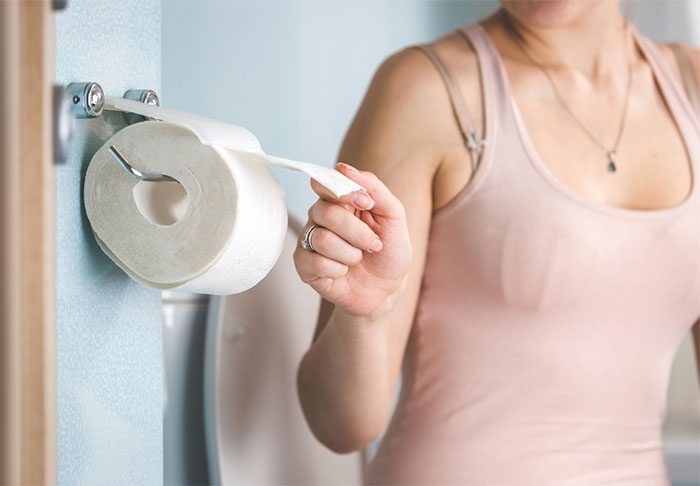Dr. Tran Ngoc Dung reported that individuals suffering from rectal prolapse often feel embarrassed and endure their condition without seeking treatment, which significantly impacts their quality of life.
Dr. Tran Ngoc Dung, from the Department of Outpatient Treatment at Hanoi University of Medicine, explained that the rectum is the section just before the anus, approximately 20 cm in length. The rectum can protrude outside the anal opening when it slips from the mucosal layer or is completely outside the anus.
Patients will notice the rectum bulging out of the anus during bowel movements. The prolapse may retract back into the anal canal on its own or can be pushed back in manually. This condition is often mistaken for hemorrhoids.

Rectal prolapse cannot resolve on its own, and the degree of prolapse will gradually increase over time. (Image: Urogyn.coloradowomenshealth).
Causes
“This condition causes discomfort for patients but rarely leads to emergencies. However, patients often feel embarrassed and tolerate the condition without seeking treatment, which significantly affects their quality of life,” Dr. Dung stated.
According to Dr. Ngoc Dung, women over 50 years old are more likely to suffer from this condition, with a risk that is six times higher than that of men. Most affected women are over 60 years old.
In addition, men suffering from rectal prolapse tend to be younger, often under 40 years old. Children under three years old can also be affected by this condition.
Types of Rectal Prolapse:
- Partial Prolapse: The rectum has prolapsed but is not outside the anus.
- Mucosal Prolapse: The mucosal layer of the rectum protrudes outside the anus.
- Complete Prolapse: The entire rectal mass protrudes through the anus, also known as total prolapse.
The causes of this condition include prolonged constipation; straining during bowel movements; weakness in the pelvic floor muscles and anal sphincter. Additionally, the condition may result from increased abdominal pressure (benign prostatic hyperplasia, cirrhosis, chronic obstructive pulmonary disease (COPD)) or abnormalities in the supportive ligaments of the rectum due to surrounding organs.
Symptoms
Dr. Tran Ngoc Dung noted that patients with rectal prolapse may experience the following symptoms:
- A sensation of a bulging mass at the anus;
- Pain and discomfort in the lower left abdominal area;
- A feeling of incomplete bowel evacuation;
- Frequent constipation or straining during bowel movements;
- Digestive disorders, involuntary bowel movements, diarrhea;
- Observation of a protruding mass from the anus at various levels according to classification.

This condition causes discomfort for patients but rarely leads to emergencies. (Image: Metrogichicago).
The severity of the condition is assessed based on the presence of bleeding from the rectal mucosa. Signs include bright red blood on the stool, even dripping blood during bowel movements; bleeding or mucus from the anus; noticing fluid or stool continuing to leak after bowel movements; difficulty in passing gas.
If left untreated, patients may face complications such as rectal ulcers and bleeding; the rectum protruding outside can cause compression and lack of blood supply; ulceration or necrosis of the prolapsed rectal segment.
Treatment
According to Dr. Dung, rectal prolapse cannot resolve on its own, and the degree of prolapse will gradually increase over time. This process can take several months or even years. Treatment depends on individual factors, including age, severity of the condition, and any other abnormalities present.
When diagnosed with rectal prolapse, you may choose to delay treatment if symptoms are mild and do not significantly interfere with your quality of life.
Treatment options include: non-medication treatment, medication treatment, and surgery.
Non-Medication Treatment
- Dietary and lifestyle changes: This includes a high-fiber diet, drinking plenty of water, and regular exercise.
- Changing bathroom habits: Avoid straining during bowel movements. Aim to have a bowel movement once daily, preferably in the morning. Before a bowel movement, you may engage in activities to help stimulate bowel motility.
Adjusting your diet and lifestyle habits to reduce constipation plays a crucial role in preventing rectal prolapse.
Medication Treatment
Medications for rectal prolapse are generally temporary and serve as a supportive measure for surgical intervention.
Some commonly used medications and formulations include:
- Serums;
- Antispasmodics;
- Gels and topical medications that help prevent infections and relieve pain;
- Medications should only be used under a doctor’s guidance after a thorough examination of the condition.
Surgery
Surgical treatment for rectal prolapse includes various methods, ranging from conservative treatment to rectal resection. Surgeries are categorized into two groups: anal surgeries and abdominal surgeries.
- Anal surgeries: Altermiere, Delorme, Chivas, Thiersch…
- Abdominal surgeries: Orr – Loygue, Ripstein, Wells…
Today, minimally invasive surgeries such as laparoscopic and robotic surgeries are also being applied in the treatment of rectal prolapse, offering high efficacy, safety, and aesthetic benefits.


















































